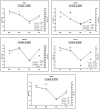Gene expression analysis of mammary tissue during fetal bud formation and growth in two pig breeds--indications of prenatal initiation of postnatal phenotypic differences
- PMID: 22537077
- PMCID: PMC3527354
- DOI: 10.1186/1471-213X-12-13
Gene expression analysis of mammary tissue during fetal bud formation and growth in two pig breeds--indications of prenatal initiation of postnatal phenotypic differences
Abstract
Background: The mammary gland is key to all mammal species; in particular in multiparous species like pigs the number and the shape of functional mammary gland complexes are major determinants of fitness. Accordingly, we aimed to catalog the genes relevant to mammogenesis in pigs. Moreover, we aimed to address the hypothesis that the extent and timing of proliferation, differentiation, and maturation processes during prenatal development contribute to postnatal numerical, morphological and functional properties of the mammary gland. Thus we focused on differentially expressed genes and networks relevant to mammary complex development in two breeds that are subject to different selection pressure on number, shape and function of teats and show largely different prevalence of non-functional inverted teats. The expression patterns of fetal mammary complexes obtained at 63 and 91 days post conception (dpc) from German Landrace (GL) and Pietrain (PI) were analyzed by Affymetrix GeneChip Porcine Genome Arrays.
Results: The expression of 11,731 probe sets was analysed between the two stages within and among breeds. The analysis showed the largest distinction of samples of the breed GL at 63 dpc from all other samples. According to Ingenuity Pathways Analysis transcripts with abundance at the four comparisons made (GL63-GL91, PI63-PI93, GL63-PI63 and GL91-PI91) were predominantly assigned to biofunctions relevant to 'cell maintenance, proliferation, differentiation and replacement', 'organismal, organ and tissue development' and 'genetic information and nucleic acid processing'. Moreover, these transcripts almost exclusively belong to canonical pathways related to signaling rather than metabolic pathways. The accumulation of transcripts that are up-regulated in GL compared to PI indicate a higher proliferating activity in GL, whereas processes related to differentiation, maturation and maintenance of cells are more prominent in PI. Differential expression was validated by quantitative RT-PCR of five genes (GAB1, MAPK9, PIK3C2B, PIK3C3 and PRKCH) that are involved in several relevant signaling pathways.
Conclusions: The results indicate that mammary complex development in PI precedes GL. The differential expression between the two breeds at fetal stages likely reflects the prenatal initiation of postnatal phenotypes concerning the number and shape as well as functionality of teats.
Figures






References
-
- Turner CW. The Development of the Mammary Gland. J Anim Sci. 1929;1929:47–51.
Publication types
MeSH terms
Substances
LinkOut - more resources
Full Text Sources
Molecular Biology Databases
Research Materials
Miscellaneous

